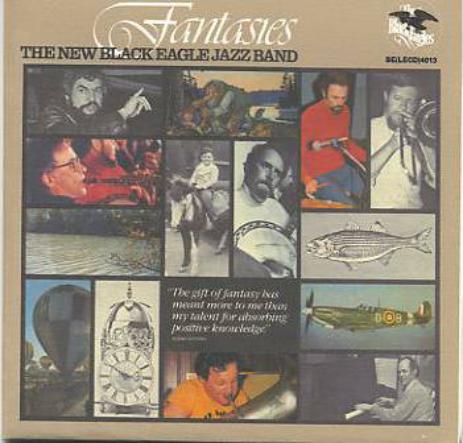by Bert Thompson
NEW BLACK EAGLE JAZZ BAND—FANTASIES (OWN LABEL: BE[LECD]4013).
Playing time: 70m. 07s.
1919 March; Rent Party Blues; Keyhole Blues; Chicago Breakdown; Song of Songs; When
I Grow Too Old to Dream; Indian Summer; Black & Tan Fantasy; Kansas City Stomps;
Egyptian Fantasy; Le Marchand de Poisson; Delia’s Gone; Sweetie Dear & When It’s
Sleepy Time down South.
Recorded at the Opera House, Wilmington, DE, on Mar. 23, 1979 (first five tracks) and
Mt. Holyoke College, South Hadley, MA, on Oct. 12, 1979 (last eight tracks).
Personnel: Tony Pringle, cornet, and leader; Stan McDonald, clarinet, soprano sax; Stan
Vincent, trombone; Peter Bullis, banjo and manager; Bob Pilsbury, piano; C. H. “Pam”
Pameijer, drums; Eli Newberger, tuba, finger cymbals.
This is the thirteenth in a series of fourteen limited edition CD’s, reissuing material by
the band that previously appeared on LP’s—mainly on their own label but also on a few
other small labels, such as Philo, Philips, and Dirty Shame—and on cassette tapes.
Some of these cassettes were issued simultaneously with the LP’s but also contained
additional tracks. Other cassettes with different material were issued in that format
only. When the company that produced the cassettes went out of business, the digital
masters were returned to the band. These form the basis of most of the material on this
CD set.
In this the penultimate disc in the set, the New Black Eagles’ tune list demonstrates once
again that their versatility is broad and their taste catholic. The composers represented
are as diverse as Duke Ellington, Sidney Bechet, Jelly Roll Morton, Sigmund Romberg,
and Victor Herbert, among others, the compositions of the latter two not usually found
in the jazz lexicon. The tune list is not replete with tired standards but rather with tunes
seldom heard and just about perfectly executed. The musicianship is, as it always
seems to be, outstanding—witness, for example, the performance of Jelly Roll Morton’s
Kansas City Stomps, a tricky tune (as all of Morton’s are). The band makes it look easy,
yet there is strict discipline needed to render the stop-time breaks we hear.
In addition to that displayed in the tune list, variety in other areas further add to the
interest the band’s performance elicits. The group is not content to follow the formula to
which so many—perhaps even the majority—of bands in the genre subscribe, namely
opening ensemble chorus / string of solos / closing ensemble chorus. Coupled with
that formula, many bands also follow the same pattern in the solos, invariably beginning
with clarinet. The New Black Eagles eschew both. Opening often with several
ensembles choruses, they sprinkle ensembles among the solos, and they frequently play
several ensemble choruses as they take the tune out, paying close attention to dynamics
as they do so and thus building the coda—and the excitement (witness the applause).
So many tunes on this CD display these features, a good example being When I Grow
Too Old to Dream.
And there are so many other devices to which one could point that contribute further to
the listener’s interest. The band is particularly adept at changing textures, dropping
from ensemble or section playing to a true solo, often that of the piano, other times
having all lay out except for a duo, such as tuba/banjo or trombone/piano. Such
changes in texture are most apparent in Delia’s Gone. And there are so many other
examples to be found, such as the shuffle rhythm introduced behind the tuba bridge in
Rent Party Blues (a lovely Ellington-Hodges number); the two-bar trading between tuba
and soprano sax for a chorus of Indian Summer; the breaks that punctuate the
descending runs in Keyhole Blues; the wood block backing in one chorus of Chicago
Breakdown; the gripping close of Egyptian Fantasy where the tuba, left totally alone,
plumbs the depth of that instrument’s bottom register, finding a note I didn’t know even
existed on that instrument, and then the soprano sax plays the same final note on top,
two octaves above. And I could cite other instances. Because of all of the above, one is
never bored, even when a tune lasts for twice the time other bands accord it.
Quoted at the head of the liner notes, Marilyn Monroe avers, “I guess I am a fantasy.”
The New Black Eagles, however, are no fantasy, but they are fantastic—as which is
invariably the case. While of course they must have a bad day now and again, it seems
inconceivable that they could do so. Certainly the two concerts from which these tracks
are taken were no such occasions and from the opening strains of 1919 March to the
closing ones of Sleepy Time Down South, they present the band in top form.
According to the band, ordering information is as follows:
The 14 CD’s are a set only in that they represent 14 reissues of LPs and Cassettes from
the earlier days of the Black Eagles. We have not priced them as a set and have typically
sold them as individual items. You can find
them by going to -
http://www.blackeagles.com/x.fullsite/cgi-bin/online-orderform.asp
To the right of the window you will see four lists - aisle 1, 2, 3 and 4. Click on aisle 2 and
you will have an order form listing all 14 of the CDs.
|
|



